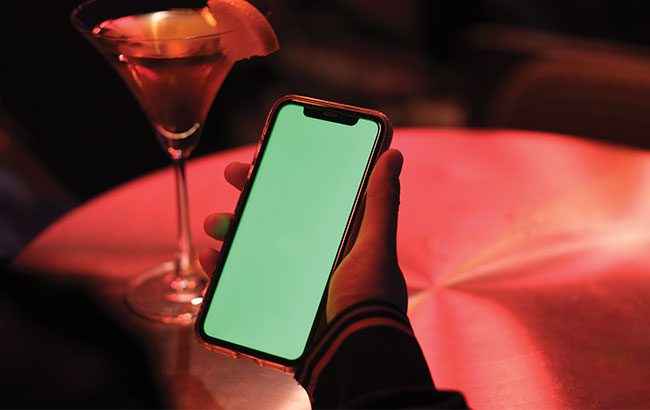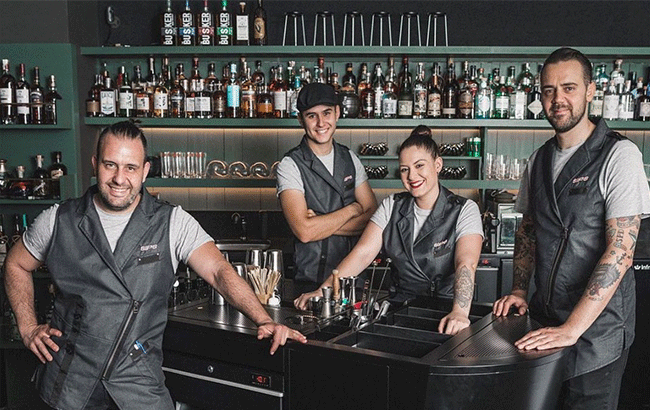How tech is helping bars survive
By Alice BrookerOne unforseen result of the pandemic is that bars and restaurants have embraced technology, with online menus, apps and QR codes coming to the fore. We examine how this tech has impacted the on-trade.

*This feature was originally published in the December 2021 issue of The Spirits Business magazine.
While the hospitality industry is largely considered to have emerged as a loser from the pandemic, some consider that venues fast-forwarding the process of going digital to be a win.
Venues stayed afloat by adopting apps for ordering and displaying menus, ensuring social distancing was maintained, displaying QR codes to check in guests, and going cashless to limit the spread of germs.
While some chains have been using apps for years, the pandemic meant more bars were using the digital bridge as a life raft, rather than an alternative choice.
Ethan Martin is the founder of Round, an app created to allow consumers to order food and drinks from their phones at hospitality venues. After launching in 2018 with a business strategy of targeting students in university cities, the app was spotlighted during the pandemic as venues adapted to the digital experience. In comparing the app’s popularity before the pandemic with now, Martin notes: “The landscape has changed so much in that time frame.”
In 2019, Martin was in talks with Stonegate, one of the UK’s largest pub companies, which has more than 700 sites. “They were looking at a small section of their group [for us]. The younger, more city-focused pub,” he says.
“The pandemic came along, and they went from ‘can you help us with this small group?’ to ‘can you help us with as many of our pubs as you possibly can?’. We went from having a few dozen venues to launching in 500 venues across the country overnight.”
But not all venues embraced the move to digital. While Martin says “the hospitality industry, in technology, is slightly behind other industries”, Kate Nicholls, chief executive of industry body UK Hospitality, notes that hospitality is viewed as “not at the cutting edge of innovation”. For this reason, despite the sector developing and implementing technology “at pace”, venues were still “very slow in rollout; there was a nervousness around what customers would want, how they would react,” she says.
Simone Caporale is the founder of Sips, a bar in Barcelona which opened in June 2021. He admits that there was “resistance in the beginning” to the digital era being ushered into bars.
“We’re getting used to life without things that aren’t essential. We can live with fewer material things,” he says. Sips opened with a digital menu – and Caporale doesn’t see this changing.
“We decided to do this for hygiene purposes – in case of cross contamination,” he explains. “Then, obviously we realised you can’t break it, don’t have to replace it, it doesn’t get stained and people don’t steal it.
“You can update it everyday, and add all the demonstrational features you want. To print a menu, you spend a few grand a year. Now you can do it online, which costs basically nothing.”

Saving money
As well as allowing operators to save money, the digitalisation of venues has also seen consumers spend more money, according to Luke Ireland, director of order-and-pay app Creventa.
Ireland points out that, when ordering at the bar, not all customers can see what is available. “You just order what you know,” he says. “People will spend more money when they can see the options in front of them. So, rather than picking a house gin, they’ll pick a premium gin.”
Ireland has found that, as “most bars and pubs have 25 to 30 gins these days”, the ability to display choice to the consumer digitally, as opposed to the range being hidden on a shelf, has resulted in “a big move to premium”.
The question remains of whether the digitalisation of the hospitality industry is here to stay. Ireland has seen unexpected benefits in the adoption of digital ordering, notably with events planning in hospitality businesses.
“There’s recently been a much bigger interest in the events business – people are more likely to preorder now. People ordering in advance helps chefs with ingredients shortages, which reduces food waste by 18%.”
Meanwhile, Martin asserts that those who have embraced his app “have seen more customers come back regularly”, are spending more, and can “communicate with and contact their customer base for the first time ever”. Those who have failed to keep up with the transition to operating on-screen will fall behind, he warns.
“They will miss out on all those benefits. Unfortunately, we’ve seen it in the industry where a number of venues will never reopen. In my mind, those are the ones very set in their ways, not trying to modernise and move forward. They’re dinosaurs.”
Indeed, Nicholls states that the technology boom in venues during the crisis has resulted in a dynamism and innovation, with “workers able to focus on delivering the most fantastic experience they can”.
All the same, industry experts are keen to emphasise that human interaction is not lost – this is still an essential part of the service. In some cases, the personable element can be improved when an app replaces the server’s role of taking orders, according to Ireland.
“When people are ordering drinks, they don’t really want a conversation. We find in venues that servers can spend more time talking to the guests when delivering drinks. It provides more interaction,” he comments.
Caporale says a staff member’s recommendation of food and drink is more important than any technological feature in a bar. “If you present a QR code – the digital menu – with a smile and greeting, then say, ‘if you want any suggestions, I’ll be here for you’, most people will say, ‘you know what, you suggest – we don’t even want to look at the menu’. That’s when human interaction is stronger than any QR code or digital feature: asking for recommendations. People like to be looked after,” he enthuses.
Furthermore, as Covid-19 restrictions ease globally and venues are given more flexibility with how they choose to operate, bars and restaurants can opt for a hybrid model of the personal and the digital.
“Offering your customers choice – that is the most important thing any brand owner or operator can do,” advises Martin.
“It doesn’t mean ‘we don’t have an app’, or ‘you can only order on the app’. The best blend is somewhere in the middle – like you can order with staff if you walk into an empty bar, but when there’s a long queue, you want the choice of ordering on your phone.”
Human value
And, despite its digital menu, Sips currently has guests order in person. “We don’t want to lose the human value that makes bars so magical,” explains Caporale.
But is a complete rejection of tech in drinking spots causing businesses to go bust? According to the National Restaurant Association, more than 110,000 eating and drinking establishments in the US closed for business – temporarily or permanently – last year.
While apps and digital menus cannot save all businesses during a pandemic, perhaps more hospitality venues would have survived if a speedier adoption of the digital world had happened.
Martin adds: “The ones that embrace technology will succeed, and the ones that don’t will either fail or wither away. That’s something that not enough people are talking about.”
Related news
Caribbean Cocktail Tour celebrates island hospitality
